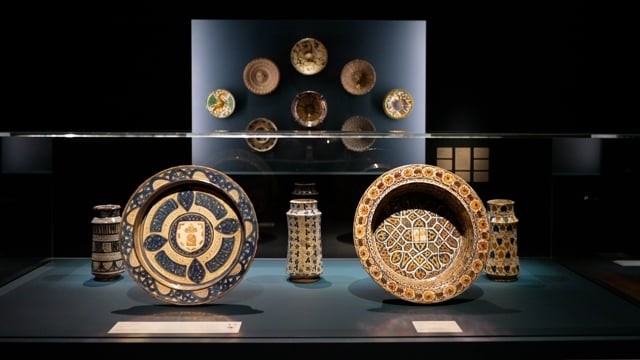
 (3 / 5)
(3 / 5)
Another centre to the Royal Academy in London would see a huge show with a massive scope spanning centuries for the art of Spain. There was a lot to get in here and I dare say I think a good three hours (consider a break in between) would be advised to drink in its entirety.
We start with the Bronze Age and Roman finds from Spain, though there a only a few items on display. A headless statue of Diana, goddess of hunting and the moon is one curiosity, the other an astounding pair of trullae, large silver spoons two thousand year olds and in phenomenal condition. Later rooms would feature the influence of Islam and the Moors, textiles becoming mainstream with intricate detailing and fine craftsmanship. Larger and larger bolts would also prove popular with wonky animals and more elaborate patterns, though this gradually grew overdone.
A dog door knocker possibly from Galicia excited one of my friends from the area on Messenger, I also noted that the map of Spain upon entry, only listed some cites and regions and not others. What did, wow were the coloured busts of saints, both the fine artistry of Juan de Juni and Pedro de Mena whited gleamed in their light and candid ecstasy. Even more amazing remained the Polychrome wooden busts of Christ and the Virgin Mary by Andrea de Mena and what remained a highlight of the whole epic show. Mary even had eyelashes…I remained floored by these two creations.
Work from their empire in the Americas would see a dazzling aqua lion water kettle, vivid plates and a statue of an angel so dramatic it somehow appeared Asian in design. The smaller things in the show would prove the triumph with ‘The Four Fates of Man: Death, Soul in Hell, Soul in Purgatory, Soul in Heaven’, attributed to Manuel Chili (called Caspicara). You can just feel the shame and guilt these little half bodied figures would install in people back then, their death metal appearance is still vivid all these years later. Some classic, conventional Goya portraits are also a delight, though I did crave some of his more twisted, unsettling works.

Many pieces do obviously feature religious subjects, more specifically Catholicism and we can see this grip loosen as the empire dies down, after looking at some famous maps of the Americas and Europe. Velazquez still has a pull over an audience all these years later, his portraits command the space. ‘El Costeño (The Young Man from the Coast)’ by José Agustin Arrieta sees a young man of colour who was possibly a slave, holding an abundance of tropical fruits, a decent painting loaded with more than you think.
The work of Joaquín Sorolla moved with it’s watery impressionistic beach scapes, really lovely just to look at. Contrasting this in the same space was Ignacio Zuloaga disturbed with ‘The Penitents’, dark and moody, blood everywhere. The show ends with a sketch of one of Sorolla’s murals ‘Vision of Spain’…but the question remains…where is the art that came out of Spain since these painters? We are talking over a century of work which has been completely ignored for perhaps a safe choice of not going into Modernism and other movements. What about Picasso? Dalí? Joan Miró? This remains a shame as it could have crowned the exhibit with a final flourish.
Spain and the Hispanic World runs till 10 April 2023 at Royal Academy of Art, London.
